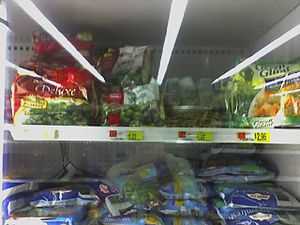Frozen vegetables

Frozen vegetables are either commercially packaged or frozen at home. A wide range of frozen vegetables are sold in supermarkets, sometimes packaged in either rectangular boxes or plastic bags.
Examples of frozen vegetables which can be found in supermarkets include spinach, broccoli, cauliflower, peas, corn, yam (in Asia) either packaged as a single ingredient or as mixtures. There are occasions when frozen vegetables are mixed with other food types, such as pasta or cheese.
Some popular brands include Birds Eye Sunbulah and Green Giant as well as supermarkets 'own brand' items.
Frozen vegetables have some advantages over fresh ones, in that they are available when the fresh counterpart is out-of-season, they have a very long shelf life when kept in a freezer and that they often have been processed a step or more closer to eating. In many cases, they may be more economical to purchase than their fresh counterparts.
While many consider frozen vegetables to be inferior to their fresh counterparts, the opposite is true in many cases. Vegetables purchased in the produce section of supermarkets have spent multiple days in transit, and many of the original nutrients may have been lost.[citation needed] It is suggested by the retailers and manufacturers that frozen vegetables are frozen at their freshest, maintaining their nutrients.[citation needed] Freezing does change the taste and texture of the vegetables, however, making them less savoury to some consumers.
Health benefits and risks
In general, boiling vegetables can cause them to lose vitamins. In particular, vitamin C and folic acid are susceptible to loss during the commercial process. Studies have also shown that thawing frozen vegetables before cooking can accelerate the loss of vitamin C.[1]
An advantage that frozen vegetables have over canned is that many brands contain little or no added salt because the freezing process by itself is able to stop bacterial growth. However, many canned vegetable brands with little or no sodium have become available and many frozen brands do have salt added for more flavour.[2]
Over the years, there has been controversy as to whether frozen vegetables are better or worse than fresh ones. Generally, reports show that frozen vegetables are as nutritionally beneficial when compared to fresh ones.[3]
According to the American Food and Drug Administration, based on a 1998 report, frozen vegetables have the same nutrients and health benefits as fresh vegetables. [4] A 2003 Austrian study found that frozen vegetables are nutritionally better than out-of-season imported fresh ones.[5]
However, there may be some risk in eating poorly cooked frozen vegetables. For example, a 2007 Australian study found that frozen vegetables may contain a bacterium called Mycobacterium avium subspecies paratuberculosis (MAP) which is resistant to extreme cold and hot temperatures.[citation needed]
Not all products classified as frozen vegetables can be viewed as health foods. On 2 June 2003, the USDA classified frozen French fries as a frozen vegetable.[6]
See also
- Frozen food
- Canned food
References
- ↑ Nursal, B.; Yücecan, S. (2000). "Vitamin C losses in some frozen vegetables due to various cooking methods". Nahrung/Food 44 (6): 451–3. doi:10.1002/1521-3803(20001201)44:6<451::AID-FOOD451>3.0.CO;2-5. PMID 11190845.
- ↑ Guidelines for a Low Sodium Diet
- ↑ Danesi, F.; Bordoni, A. (2008). "Effect of Home Freezing and Italian Style of Cooking on Antioxidant Activity of Edible Vegetables". Journal of Food Science 73 (6): H109–12. doi:10.1111/j.1750-3841.2008.00826.x. PMID 19241586.
- ↑ Fresh vs. Frozen? Choosing your fruits and vegetables
- ↑ Frozen Vegetables Often Healthier Than Fresh
- ↑ USDA Classifies Frozen Fries as "Fresh Vegetables"